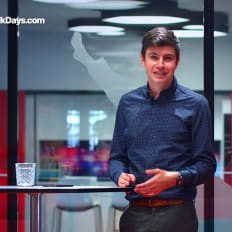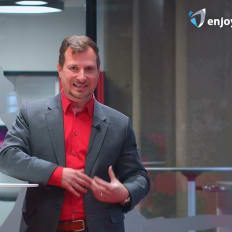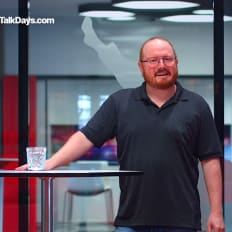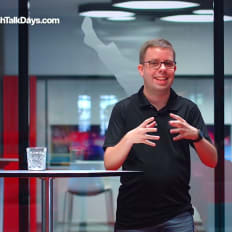
enjoy IT GmbH
Joachim Waldl, Front End Developer bei enjoy IT
Description
Joachim Waldl von enjoy IT gibt im Interview einen Einblick in seinen Werdegang zum Programmieren, einen Überblick in seine aktuelle Arbeit im Front End Development und schließlich Tipps für Beginner.
By playing the video, you agree to data transfer to YouTube and acknowledge the privacy policy.
Video Summary
In "Joachim Waldl, Front End Developer bei enjoy IT," Speaker Joachim Waldl explains how an early start with computers and studying at an HTL led him into frontend development, and how he began his current work alongside his studies. He covers tasks ranging from minor UI tweaks to building full web applications with industry-used JavaScript frameworks, integrating backend APIs and sometimes shaping the design himself. His advice: university isn’t required—prioritize a portfolio, hands-on projects (e.g., with Vue.js), and solid skills in HTML, CSS, JavaScript, and ideally TypeScript.
From HTL Foundations to a Front-End Career: Key Takeaways from “Joachim Waldl, Front End Developer bei enjoy IT”
A journey that started early
In “Joachim Waldl, Front End Developer bei enjoy IT,” speaker Joachim Waldl (enjoy IT GmbH) traces a straightforward, grounded path into front-end development: early curiosity, deliberate education, and a steady transition into professional practice. What stands out first is how early his IT story begins. Computers were present thanks to his brothers, and that initial spark turned into concrete steps through school and work.
After finishing lower secondary school, he chose a technical high school (HTL) in Information Technology, learned programming fundamentals, and in the third year discovered front-end development—HTML, JavaScript, CSS, and also PHP. The sequence is familiar: fundamentals first, then a focus area. And the moment he encountered front-end, he liked it.
This is precisely what makes Joachim’s story relatable for aspiring developers: there’s no single “correct” path, but there are consistent patterns that reduce friction—hands-on practice, a knack for tinkering, and the willingness to narrow your focus once you’ve explored the basics.
Education as a springboard: why HTL mattered
Joachim recalls, “after lower secondary school,” he decided to start at HTL in Information Technology. There he gathered his first programming experience and, by the third year, got into front-end topics: HTML, JavaScript, CSS, and PHP.
That progression—foundations, then specialization—helps build the frame for everything that follows. HTML brings structure, CSS defines presentation, JavaScript enables interactivity. PHP adds a server-side dimension, which is useful for understanding how data arrives and how the front-end and back-end meet.
Joachim “liked” front-end early on. If you enjoy a space where feedback is immediate (a click and the UI responds) and where there’s room for taste and aesthetics, front-end can feel at once playful and rigorous. His later choices reinforce that initial appeal.
After HTL: service year, university, and ongoing front-end practice
Post-HTL and after his compulsory service year, Joachim was already “hooked” on front-end. He decided to pursue university, too, and crucially, he didn’t treat it as either/or. He started working “alongside” his studies as a front-end developer in his current role—and he has stayed with front-end ever since.
That parallel track—formal learning plus real projects—proves powerful. Theory never floats untethered; it lands in day-to-day work. Practical wisdom accumulates: translating abstract concepts into interfaces, interpreting requirements, and navigating a workflow that spans design input, data integration, and delivery.
What front-end work means in practice
Joachim maps the scope with disarming precision: tasks range “from the smallest adjustments on a website … so that a button looks a bit different … or text is displayed a bit differently,” all the way to “building web applications from scratch with various JavaScript frameworks used in the industry.” Two truths sit inside that description:
- Front-end often begins in the small: a button, a margin, a text rendering detail. These are the touchpoints that shape usability.
- Front-end also spans the large: end-to-end applications, data flows, and the architectural choices that make a product coherent.
The power of seemingly small changes
“Make the button look a bit different” sounds simple; in practice it touches accessibility, responsive layout, contrast and readability, focus states, and micro-interactions. The same goes for adjusting text presentation—typography, spacing, and flow. This is where craftsmanship shows. Take these tiny layers seriously, and you improve products every day.
Building from scratch: where architecture meets UX
At the other end of the spectrum are applications “from the ground up.” Here you’re thinking about structure, performance-sensitive render paths, state handling, routing, internationalization, and testability—without losing sight of the boundary to back-end. Joachim stresses “various JavaScript frameworks … used in the industry.” He doesn’t list them, but the point stands: framework competence is a proxy for production readiness. It’s less about buzzwords than about being able to build maintainable, modern front-ends.
Interface, not isolation: collaborating with the back-end
Joachim describes the default setup simply: “You get interfaces from the back end and receive the data,” and the client’s instruction is that those data “should be presented nicely.” That is a compact brief: understand the data, translate them into usable views, and design interaction and flow so people can actually get things done.
From a front-end vantage point, that means:
- Read the data model: which fields matter, what states can occur?
- Choose representations: lists, cards, detail views, forms—what fits the job?
- Get loading and error states right: spinners, skeletons, placeholders, and a sense of liveness while data arrive.
- Keep patterns consistent: once discovered, reuse them to reduce cognitive load.
Design handoff vs. creative freedom
“Sometimes you get a design to follow, sometimes you’re told it should ‘look nice.’” These two modes shape the workflow:
- With a fixed design: honor the layout’s intent, aim for pixel-accuracy where it matters, and carry accessibility considerations through the build.
- Without a design: establish information hierarchy, choose sensible defaults, and define visual weight and rhythm. Here, front-end overlaps with product thinking.
Joachim enjoys that interplay. He “always wanted to work a bit creatively,” but still feels at home “in the logical IT environment.” That tension captures the essence: front-end is design-inflected work governed by logic, not arbitrary aesthetics or pure math detached from human use.
The “overall picture” as a guiding principle
Joachim talks about creating a “Gesamtbild”—an overall picture. That implies consistently relating local UI decisions to the whole: language, tone, interactions, states. It’s orchestration more than mere assembly. A button here, a form there—yet what matters is how it all hangs together.
How to get started: portfolio, frameworks, and self-learning
Joachim learned front-end primarily through HTL. For today’s learners, he points out that “there are many courses online,” and he states plainly: “University is not a must.” What matters is to “build a portfolio,” “get in touch with these JavaScript frameworks,” and, as a concrete example, “set up projects for clients with Vue.js.” Also, be able to show work done with “HTML … CSS and JavaScript,” and “maybe even TypeScript.” His principle is crisp: “The more you teach yourself, the better it comes across.”
From his remarks, five practical directives emerge:
1) Treat the portfolio as evidence
- It’s more than a list. Show traceable decisions. If you can demonstrate both small UI tweaks and from-scratch applications, you’re exhibiting the breadth Joachim describes.
- Make the context legible: Where did the data come from? Was there a design to follow? What was the path from brief to result?
2) Framework contact beats framework collecting
- The point isn’t name-dropping. It’s hands-on experience with “various JavaScript frameworks used in the industry,” exemplified by his mention of “Vue.js … for example.” Focused learning and real application count more than long stacks on a CV.
3) Honor the fundamentals: HTML, CSS, JavaScript
- This triad is front-end literacy. Even inside framework ecosystems, you’ll rely on solid markup, well-structured styles, and clear, intentional interactions.
4) Use TypeScript as a quality lever
- “Maybe even TypeScript” signals a plus factor rather than a baseline. Type safety disciplines code, makes data flows explicit, and strengthens collaboration. Teaching it to yourself shows you care about quality and maintainability.
5) Make self-learning a habit
- “The more you teach yourself, the better it comes across.” Read documentation, spin up small proof-of-concepts, try concepts in mini-projects, and reflect learnings in your portfolio.
Practice arenas implicit in Joachim’s story
Without venturing beyond the talk, Joachim’s description suggests concrete practice areas, tightly aligned with his points:
- UI micro-work: restyle a button end-to-end (hover, focus, disabled). Adjust text appearance with thoughtful typography and spacing.
- Data presentation: think through a delivered API scenario and design list and detail views plus loading states.
- With and without design: build a view faithfully to a handed-off design; build a second view from the same data without a predefined design.
- From component to app: start with a single component and evolve it into a small, “from scratch” web application—navigation, state, error handling, deployment.
- Framework touchpoint: set up a project “for example with Vue.js” and implement the same aspects.
Each area feeds into the portfolio Joachim emphasizes and trains the balance between precision, pragmatism, and aesthetics.
Collaboration done well: aligning roles and expectations
The front-end/back-end handoff Joachim mentions is the typical pattern: interfaces deliver data, the front-end presents them. Sometimes there’s a design to follow; sometimes the brief is open. From this mix arise expectations worth clarifying:
- What’s the source of truth? If the data model changes, how does the front-end find out?
- What does “look nice” mean to stakeholders? Minimalist, playful, dense with information?
- Which states are critical? Load times, error conditions, edge cases—they shape whether an app feels robust.
Experience with both “smallest adjustments” and building an app “from scratch” equips you to resolve such questions smoothly. Detail work and architecture belong together.
Creativity and logic: a productive tension
“I always wanted to work a bit creatively,” Joachim says, while also feeling at home “in the logical IT environment.” Many front-end developers recognize that blend. The creative dimension includes color, type, layout, animation taste, and microcopy. The logical dimension covers state modeling, interaction rules, accessibility, and performance. Bringing both together creates that “overall picture” he talks about—beyond mere functioning, toward something coherent and dependable.
For a portfolio, this means showing more than screens. Make decision-making visible. What assumptions informed the design? How was a layout translated into reusable components? Which states were modeled? This documentation exposes the thinking that distinguishes front-end engineering from surface-level styling.
Education today: university as option, not obligation
Joachim says it plainly: “University is not a must.” He himself chose to study after HTL, but he emphasizes what truly matters: “build a portfolio,” “get in touch with … JavaScript frameworks,” “set up projects … for example with Vue.js,” and show that you’ve worked with “HTML … CSS and JavaScript … maybe even TypeScript.”
The implication is equally plain: employers look for demonstrated competence. Practical results can outweigh formal credentials, as long as the work is strong. For newcomers, that’s liberating: the door is open if you can show you can deliver.
A motivating path and a compass for your own
Joachim’s path—early start, solid foundations, discovery of a front-end focus, parallel growth in study and work, and a clear enjoyment of the creative-logic mix—offers a simple compass. No theatrics, no exaggeration. It’s the craft perspective of a practitioner who knows the job: improve the small, build the big, work with data, implement designs—or make good calls without a design when needed.
The practical message for anyone entering front-end today is clear:
- Start with what you control: HTML, CSS, JavaScript.
- Build contact with a modern framework—“for example, Vue.js.”
- Practice on realistic data: think through interfaces and design states.
- Train both modes: tight design handoff and open briefs (“make it look nice”).
- Capture your results—a portfolio that makes decisions legible.
- Keep learning: “The more you teach yourself, the better it comes across.”
Quotes and lines that stick
Several lines from “Joachim Waldl, Front End Developer bei enjoy IT” capture the job’s essence:
“… from the smallest adjustments … to building web applications from scratch …”
“You get interfaces from the back end … and the client wants the data presented nicely.”
“Sometimes you get a design … sometimes you’re told it should look nice.”
“I always wanted to work a bit creatively … and I feel comfortable in the logical IT environment.”
“University is not a must … build a portfolio … get in touch with JavaScript frameworks … for example with Vue.js … HTML … CSS and JavaScript … maybe even TypeScript.”
These lines speak to a professional stance that is both sober and ambitious—the combination that makes modern front-end teams strong.
Conclusion: front-end as a learnable, living practice
“Joachim Waldl, Front End Developer bei enjoy IT” shows how a front-end career can unfold when early curiosity, solid foundations, and continuous self-learning align. Joachim positions front-end as a living practice that alternates between fine-grained polish and systems-building, between interpreting designs and presenting data, between creativity and logic.
For anyone modeling their path on his, the call to action is straightforward: make your work visible, learn methodically, practice on real-feeling tasks—and keep the joy of making things look good without neglecting technical substance. That balance is where the “overall picture” Joachim mentions emerges—and where front-end work becomes truly impactful.
More Dev Stories

enjoy IT GmbH Julian Deleja-Hotko, Software Developer bei enjoy IT
Julian Deleja-Hotko von enjoy IT redet im Interview über seine Anfänge mit dem Programmieren, was er in seiner aktuellen Arbeit macht und was seiner Meinung nach für Neueinsteiger wichtig ist.
Watch now
enjoy IT GmbH Stefan Weinzettel, Bid Manager bei enjoy IT
Stefan Weinzettel von enjoy IT berichtet im Interview über seinen Weg in das Bid Management, wie er in seiner Rolle im Unternehmen mit Developern zusammenarbeitet und gibt Tipps für Einsteiger.
Watch now
enjoy IT GmbH Thomas Hochgatterer, Back End Developer bei enjoy IT
Thomas Hochgatterer von enjoy IT gibt im Interview Einblicke in seinen Werdegang mit dem Prorammieren, wie sich sein Arbeitsalltag als Back End Developer gestaltet und gibt Tipps für Neueinsteiger.
Watch now
enjoy IT GmbH Christof Amtmann, Project Manager bei enjoy IT
Christof Amtmann von enjoy IT spricht im Interview darüber, wie er über Umwege zum Project Management gekommen ist, was seine aktuelle Arbeit umfasst und gibt Tipps für Neueinsteiger.
Watch now
enjoy IT GmbH Oktay Akgül, Lead Developer bei enjoy IT
Oktay Akgül von enjoy IT erzählt im Interview wie er zum Programmieren gekommen ist, wie sich dann der Weg bis zu aktuellen Arbeit als Lead Developer gestaltet hat und gibt Tipps für Neueinsteiger.
Watch now
enjoy IT GmbH Thomas Hintersteiner, Software Architect bei enjoy IT
Thomas Hintersteiner von enjoy IT erzählt im Interview über seinen Weg – angefangen von der HTL bis hin zu seiner aktuellen Arbeit – und gibt Tipps für Personen die selbst mit dem Programmieren anfangen möchten.
Watch now






